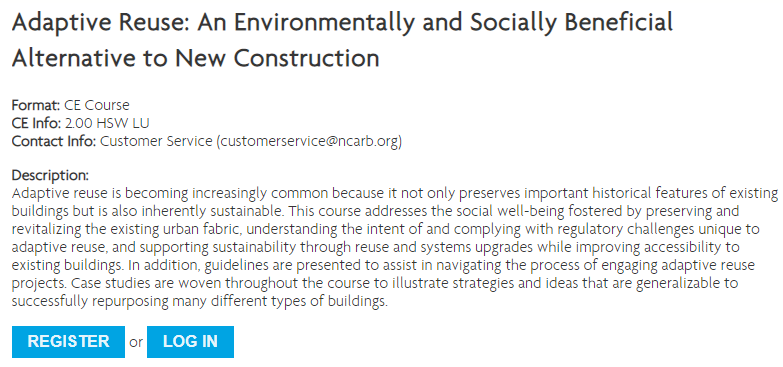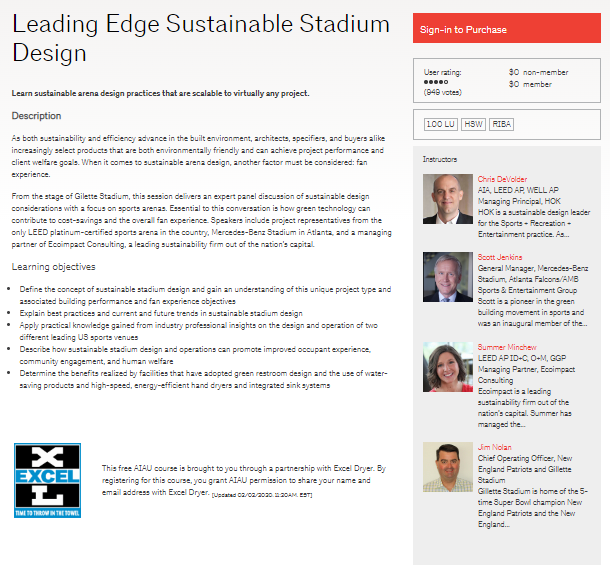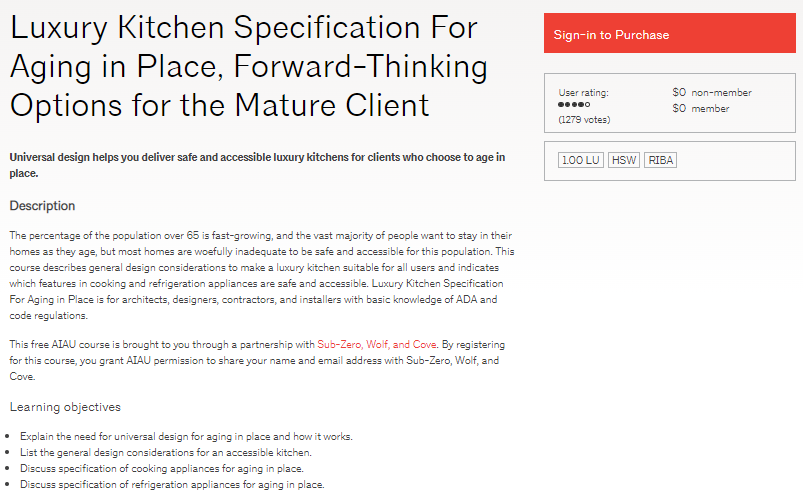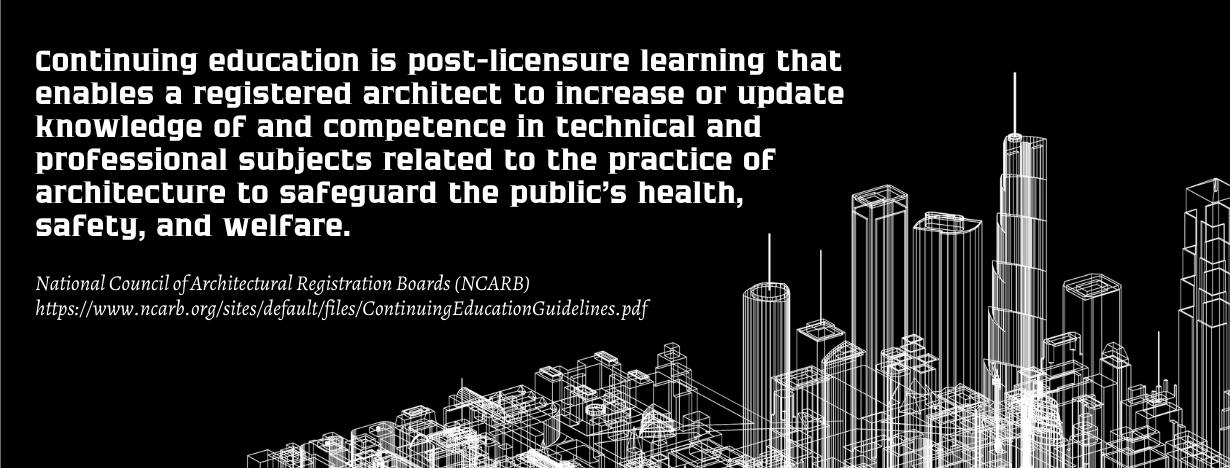10 Free Continuing Education (CE) Courses for Architects
Find your perfect college degree
Obtaining a license is the first major undertaking of every graduate of architecture. It is a turning point that will lead you to a new and better world where you can exercise a profession legally and with authority.
However, getting licensed is not the end of your professional mission as an architect. You need to renew your license to keep it valid. One of the most important and indispensable requirements for license renewal is continuing education.
As you may know, continuing education means added cost, especially if it comes from commercial CE providers. For this reason and to make things lighter for you, some professional architects’ organizations have decided to offer free courses for the continued education of building design professionals. Here are some for your information and convenience.
The Lowdown
Continuing education is an ongoing learning process for licensed building design pros. You should earn CE credits to increase your understanding and update you on the latest developments, technologies, and practices in architecture. It increases your competence and makes you more capable of safeguarding public health, safety, and welfare (HSW) in the exercise of your profession.
As your opportunity in the thriving industry of construction grows exponentially, the need for continuing education courses is not limited to keeping your architect’s license active, It also enables you to acquire additional skills or hone what you already have especially in new software applications, and learn new methods of ensuring public health, safety, and welfare.
The architect continuing education course, as a requirement to maintain a license or renew it varies from one state to another. To learn about jurisdiction-specific CE requirements, you may use this License Requirements Tool from the National Council of Architectural Registration Boards (NCARB).
10 Free Continuing Education (CE) Courses for Architects
Finishing Gypsum Board Because Appearance Matters

Provider: Ron Blank & Associates, Inc.
This one-hour, free video course sponsored by National Gypsum allows professional building design creators to explore varying levels of gypsum board finishes and determine when to apply them based on the needs of your project.
Best Features:
- Enables participants to understand the importance of indoor air quality.
- Provide learners with a deep understanding of the impact of gypsum on indoor air quality.
- Enable participants to identify the differences between the different finish levels for gypsum panel products.
- Identify typical mistakes in the use and application of gypsum as a board material.
- Recognized by the Alberta Association of Architects (AAA), American Institute of Architects (AIA), American Institute of Building Design (AIBD), and Building Owners and Managers. Institute International, Inc. (BOMI), Ontario Association of Architects (OAA), and Saskatchewan Association of Architects, Canada (SAA).
- Available Online.
- Participants who complete the course and pass the test are granted one hour of CE credits by accrediting professional organizations.
Stunning Design Within Your Grasp: Architectural Railing Systems

Provider: Ron Blank & Associates, Inc.
Sponsored by Livers Bronze, this one-hour video CE course for architects focuses on the safety aspect and not just the aesthetic factor that goes with guardrails and handrails that we often see on balconies and stairs. It aims to give you a deep understanding of the importance of proper specification in the design and fabrication of guardrails and handrails.
Best Features:
- It makes learners understand the importance of choosing the right decorative railing manufacturer to ensure its products are safe for users and installers.
- Make learners understand the value and advantages of using a single-source provider.
- Recognized by the AIA, AAA, BOMI, AIBD, OAA, and SAA.
- Available online.
- Participants who can complete the course and pass the quiz will receive a certificate and earn one hour of CE credit from professional organizations that recognize the program.
Advanced Rainscreen Design for Moisture Management

Provider: Ron Blank & Associates, Inc.
This James Hardie-sponsored narrated video course intends to strengthen your grasp on moisture management in building envelopes and related systems. It also aims to give you a good understanding of some of the design requirements set forth by codes and standards and integrate rainscreens into your building envelope system.
Best Features:
- Designed to inform designers in the management of moisture in buildings.
- Enables professional designers to learn about different types of excellent rainscreen systems.
- Recognized by prestigious professional architects’ organizations in America, such as the AAA, AIA, AIBD, BOMI, OAA, and SAA, as continuing education learning hours.
- Available online.
- Learners who complete the course and pass the quiz will receive one hour of continuing professional development (CPD) from professional organizations that accept the program
Facades & Insulation: Uniting Fire & Thermal Performance

Provider: AEC Daily
This 1.25-hour Health, Safety and Welfare-eligible CE course, sponsored by Kingspan Insulated Panels, focuses on the importance of selecting metal cladding systems to meet thermal performance requirements without compromising safety.
Best Features:
- This self-paced online CE course makes a comparison of different core materials. It focuses on the code’s requirement for the performance of metal cladding materials based on fire test results.
- Features case studies from fire events from various places around the world.
- This course is accepted as a continuous education HSW learning unit by 25 industry associations, including AIA, AIC, BOMI, AIBD, AAA, OAA, HSW, and SAA.
- Participants will earn a 1.25 learning unit or CPD hour.
- Available through the internet.
Fire & Smoke Protection with Life Safety Dampers

Provider: AEC Daily
Another fire and smoke protection self-paced CE course, this Mestek Commercial Damper and Louver Group-sponsored and HSW-eligible program, focuses on the many applications of life safety dampers to protect buildings from fire.
Best Features:
- Allows course participants to take an in-depth look at various types of dampers and provide them with details of the use and installation of each type.
- Recognized as a 1.25 HSW learning unit by 27 industry associations, including AIA, BOMI, AIC, AAA, AIBD, OAA, HSW, and SAA.
- Participants of this program will earn a 1.25 learning unit or Continuing Professional Development (CPD) hour.
- Accessible via the internet.
Safe Water Delivery in Healthcare Facilities

Provider: AEC Daily
The Safe Water Delivery in Healthcare Facilities is a Morris Group-sponsored one-hour CE program intended to make learners aware of the presence of waterborne bacteria and viruses and to prevent harmful organisms from getting their way into our healthcare facilities by stopping them right at the source.
Best Features:
- The course highlights the concerns and possible consequences of improper water delivery in healthcare facilities.
- Provides an explanation of why the course facilitators are designing a safety feature that monitors and manages water delivery projects to prevent contamination.
- Honored as 1.0 CE HSW learning units or CPD credit by 27 industry associations, including AIA, AIC, BOMI, AIBD, AAA, OAA, HSW, and SAA
- Accessible through the internet.
Adaptive Reuse: An Environmentally and Socially Beneficial Alternative to New Construction

Provider: National Council of Architectural Registration Boards (NCARB)
Many existing buildings carry important historical features, and for this reason, they need to be preserved through adaptive reuse. This topic is the main focus of this HSW-eligible self-paced course that students can download as a 102-page article.
Best Features:
- Fosters the preservation and revitalizing of existing urban buildings and structures
- Learners understand the intent and regulatory issues relating to adaptive reuse as an alternative to new construction
- Uses case studies to demonstrate ideas and strategies for repurposing different types of buildings
- Makes participants earn 2.0 HSW learning units
- Available from the web
Mitigating Thermal Bridging with Fluid-Applied Coatings

Provider: American Institute of Architects
This online self-paced course for architects, sponsored by Tnemec, focuses on the importance of using fluid-applied coatings as a measure to reduce thermal bridging in existing and newly constructed buildings.
Best Features:
- Provides participants with a good understanding of why, how, and when thermal bridging is a problem in buildings.
- Learners see the beneficial uses of fluid-applied coating, especially in addressing issues concerning indoor air quality and reducing thermal bridging.
- Provides participants with an overview of fuel-applied coatings and aerogel particles and explains their capability to mitigate condensation.
- Participants of this program will earn .50 HSW & Royal Institute of British Architects (RIBA) LU.
- Web-based.
- Given free whether you are an AIA member or not
Leading Edge Sustainable Stadium Design

Provider: American Institute of Architects
The sustainability and efficiency of built environments are primary factors that building design pros consider. While every designer focuses on these components in selecting environment-friendly products, this Excel Dryer-sponsored course recognizes the value of another equally valuable aspect of stadium design – fan experience.
Best Features:
- This online course is a panel discussion of building design and construction experts who share and contribute their views about sustainable sports arena designs and projects.
- It explains the role of green technology in energy efficiency and overall fan experience in stadiums.
- It features renowned representatives from the only Leadership in Energy and Environmental Design (LEED)-certified sports arena in the US, Mercedez-Benz Stadium n Atlanta, GA., and a managing partner of a leading sustainability firm in the country.
- It makes participants understand the best practices and benefits of sustainable stadium design.
- Participants earn 1.0 HSW & Royal Institute of British Architects (RIBA) Learning Unit.
- Available from the web
- Free
Luxury Kitchen Specification For Aging in Place, Forward-Thinking Options for the Mature Client

Provider: American Institute of Architects
This architect continuing education course is designed to educate design professionals on the design of kitchens that are adequate, safe, and accessible for people over 65 years old. This program is sponsored by Sub-Zero, Wolf, and Cove.
Best Features:
- This architect CE program explains the necessity for a universal design for people who choose to age in their own homes and provides details of its working principles
- Enumerates several accessible kitchen design considerations
- Presents specifications of cooking and refrigeration appliances for aged individuals
- Provides participants with a 1.0 HSW & Royal Institute of British Architects (RIBA) Learning Unit.
- Free of charge whether you are a member of AIA or not
Understanding the Importance of Free Continuing Education for Architects
License Renewal Requires Continuing Education
Free continuing education is not a specific prerequisite for an architect to maintain a license or have it renewed but continuing education. But since the cost is a matter of concern for everyone involved in acquiring products or services, it does make a difference.
Except for architects in Arizona, Connecticut, Maine, North Dakota, Pennsylvania, and the U.S. Virgin Islands, all building design professionals who wish to renew their licenses are required to earn CE credits or learning units.
Free Continuing Education Boosts Your Personal and Professional Opportunities
- It updates you on the latest trends, tools, and practices in the industry and enhances your understanding of your craft.
- Added knowledge and skills from CE programs can boost your competence and self-confidence.
- Improved competence increases your job marketability and potential for professional growth
- Together, these elements can raise your potential for financial success, which benefits your entire family.
Frequently Asked Questions
What is continuing education for architects?
Continuing education is a type of learning that professional building designers acquire post-licensure to increase or update their knowledge of professional subjects and boost their competence to ensure that the health, safety, and welfare of the public are safeguarded.
How can I earn continuing education credits?
To earn continuing education credits or learning units (LUs), you must complete approved learning programs from duly accredited continuing education providers. An hour of continuing education earns one learning unit.
What program formats are accepted for credit?
These program formats are eligible for CE credit:
- Live in-person programs
- Live online courses in the form of webinars, streamed videos, etc.
- On-demand downloadable articles or podcasts
What is HSW for architects?
HSW stands for Health, Safety, and Welfare. In architecture, HSW is anything that impacts the structural integrity and the effects of a building project or its site on the public.
Can an unlicensed graduate apply for membership with the American Institute of Architects?
Yes. While AIA members are expected to be licensed US architects, it accepts associate members who are:
- Unlicensed holders of BS Architecture degree with recent graduate information
- Unlicensed graduates who are currently working under the supervision of a licensed architect
- Architecture graduates who are currently undergoing an Intern Development Program and aiming for a license
- Faculty members of a university’s BS Architecture program
If you are on your way to getting a license, you may explore some AIA-approved courses that licensing board may consider as an experience which is one of the requirements for licensure.

Summary Points
There are over 3,000 CE providers for architects and hundreds of online courses in more than 75,000 approved CE programs for you to choose from. Many of them will meet your ongoing education requirements and help you grow professionally.
Whatever course you choose, whether it’s free or paid, be sure that it carries approved learning units to make sure that it meets your state’s licensure requirements and the criteria of acceptability to a professional organization that you wish to join.
Another thing you must seriously consider is the relevance and applicability of the course to your current job. Studying something outside your current field wouldn’t make sense if you can’t apply it. It might not be able to give you the professional and financial success continuous learning for professional building designers has promised.
Additional Information:




